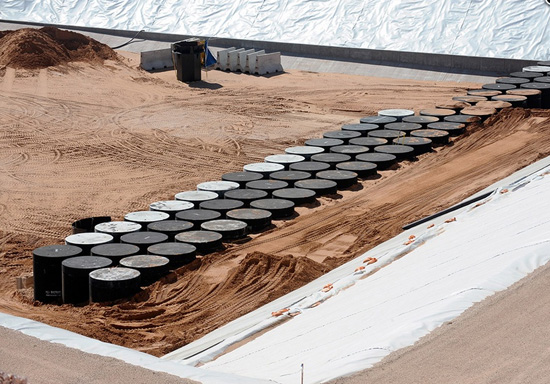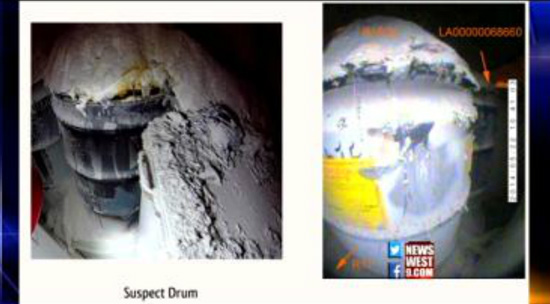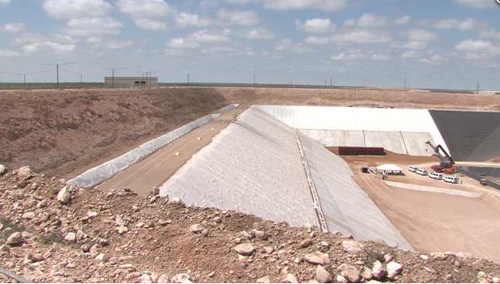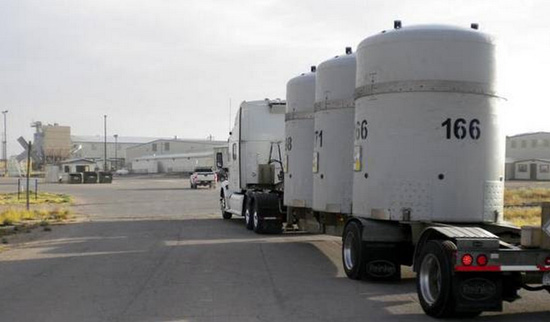Archive for the ‘WCS’ Category
WCS’s Hiring of Legislative Aide Draws Ethics Concerns
May 13, 2014
by Jim Malewitz

Modular concrete canisters containing nuclear waste are shown at the bottom of a storage pit near Andrews, Texas.
Photo by: David Bowser
Betsy Madru, the new vice president of government affairs at Waste Control Specialists, should have no trouble connecting with key lawmakers about policy that affects the billion-dollar company. She could either phone her old boss or simply look across the dinner table.
Madru, who began May 1 in a position that involves outreach to state officials, previously served as legislative director for state Sen. Kel Seliger, R-Amarillo. Seliger’s district includes Andrews County, home to the company’s vast storage and disposal site for hazardous and low-level nuclear waste, and Seliger has sponsored legislation that has allowed the company to expand the scope of waste it accepts. Madru worked on that policy. And Madru’s husband, Dan, a senior policy adviser for Texas House Speaker Joe Straus, has worked on a range of energy and natural resources issues, including radioactive waste disposal.
Straus this year instructed lawmakers to study the economic potential of storing highly radioactive nuclear waste in Texas that is stronger than WCS holds. If that long-shot idea became reality, it could yield billions more for WCS and the state.
Asked about Dan Madru’s involvement with environmental policy, a spokesman for Straus’ office released a statement late Monday saying that Madru’s role had changed.
"Speaker Straus and his entire staff take even the appearance of conflicts of interest very seriously, which is why Mr. Madru is no longer working on issues related to the environment,” Jason Embry, the spokesman said. “The Speaker and Mr. Madru are currently weighing other possible measures to ensure that no potential for conflicts, actual or perceived, exists."
Betsy Madru said there was nothing improper about her move. Critics, however, say it looks like a two-pronged conflict of interest. Though such jumps from state government to the private sector are legal and common, Madru’s additional connection to Straus made her case more problematic, said Fred Lewis, an ethics watchdog who is active in Democratic politics. Lewis spoke to The Texas Tribune before Straus’ office announced it had changed Dan Madru’s role. He had called Madru’s connections a "pretty obvious" conflict that "just makes people more cynical" about government.
"The spousal connection is worse," he said, because the Madrus would have simultaneous interests in the company and lawmakers who set its rules that affect the company.
Betsy Madru, who began working in Seliger’s office in 2010 after spending five years at the Texas Commission on Environmental Quality, said, "It’s always fair to raise questions, but do I think that there is an issue with impropriety? No, I don’t."
"We have to be aware of it, and it would be irresponsible not to be aware, so we have to take that very seriously," she said, adding that she and her husband would " uphold the utmost professionalism."
WCS, formerly owned by the late Dallas billionaire Harold Simmons, is one of few sites in the nation that is licensed to store low-level radioactive waste. It has been storing contaminated items from shuttered reactors and hospitals at its site in rural West Texas since 2012.
The company, along with state and federal regulators, has repeatedly called the site safe. But environmental groups have scrutinized the facility as it has expanded the scale of waste it accepts, raising concerns about the effects on groundwater and other natural resources.
The company’s critics also raised questions about whether the millions of dollars Simmons donated over the years to Republican state lawmakers, including Gov. Rick Perry, influenced state decisions on waste policy, but Simmons had said he believed that Perry had Texans’ best interests in mind.
Chuck McDonald, a WCS spokesman, said the company needed to add Madru’s position as its business rapidly expands. He said he understands any ethical concerns about the hiring. "But from our point of view," he said, "if we’re looking to add a public affairs position at our company, we want someone who has experience in government and, more important, experience in our issue."
McDonald said that anyone who has been involved with Texas waste policy over the years — including the company’s critics — should be pleased that WCS has added a familiar face and someone who had developed an expertise on such complex issues.
Seliger said he understands why ethics concerns would exist, but said he does not see any ethical issues with the move.
"She understands what the Legislature’s take in many instances are on waste issues, and that’s sometimes in conflict with what WCS would like to do,” he said. “She’s going to be a pretty good arbiter of those issues."
During Madru’s stint in Seliger’s office, the lawmaker sponsored successful legislation that enabled WCS to begin accepting low-level radioactive waste from many states and a bill that allowed states to send more concentrated, or "hotter," waste.
In October 2013, Seliger and Madru were among several lawmakers and staffers whom WCS flew to Andrews for a "fact-finding trip," according to a lobby activities report filed with the Texas Ethics Commission. Madru said the trip, which included a tour of the facility in which she learned how the disposal site functions, occurred far before she contemplated working with the company.
Tom "Smitty" Smith, director of the Texas office of Public Citizen, which opposes storing radioactive waste in Texas, said he found nothing comforting in the hire. "Frankly, I’m horrified for all those reasons — that she’s smart, persuasive and she knows where all the flaws in the regulations are."
This document contains copyrighted material whose use has not been specifically authorized by the copyright owner. SEED Coalition is making this article available in our efforts to advance understanding of ecological sustainability, human rights, economic democracy and social justice issues. We believe that this constitutes a "fair use" of the copyrighted material as provided for in section 107 of the US Copyright Law. If you wish to use this copyrighted material for purposes of your own that go beyond "fair use", you must obtain permission from the copyright owner.
Five Suspect LANL Waste Containers Sent to Waste Control Specialists Site in Texas
Jun 12 2014
NuclearStreet
Department of Energy investigators have narrowed their focus to the contents of six transuranic waste containers destined for the Waste Isolation Pilot Plant, five of which were diverted to a site in Texas after a leak at WIPP in February.
Quoting legislative testimony by the head of New Mexico’s Environment Department Tuesday, the Albuquerque Journal reported that five containers from Los Alamos National Laboratory are being stored by Waste Control Specialists, which has buried suspect LANL waste to keep it temperature-stable. The other LANL container inside the WIPP repository in New Mexico is believed to be the source of a Feb. 14 radiation leak after a chemical reaction cracked its lid.
A LANL spokesman speaking with the Santa Fe New Mexican acknowledged weaknesses in the lab’s procedures related to changes in the material used to stabilize the waste. Researchers initially focused on a change from clay-based to organic kitty litter. Legislative testimony suggested the absorbent material provided fuel for the heat event that cracked the container but did not initiate the chemical reaction, which scientists so far have not been able to replicate. The other trait the six drums share is particularly acidic waste material from evaporators used in weapons development. Recently publicized emails show that LANL granted permission last summer for EnergySolutions to add a neutralizer to that waste that also held the potential for reactivity.
This document contains copyrighted material whose use has not been specifically authorized by the copyright owner. SEED Coalition is making this article available in our efforts to advance understanding of ecological sustainability, human rights, economic democracy and social justice issues. We believe that this constitutes a "fair use" of the copyrighted material as provided for in section 107 of the US Copyright Law. If you wish to use this copyrighted material for purposes of your own that go beyond "fair use", you must obtain permission from the copyright owner.
Five Highly Acidic Radioactive Waste Containers Stored in Andrews, Spokesman Says Public is Not in Danger
Jun 11, 2014
By Alicia Neaves
NewsWest 9

ANDREWS – NewsWest 9 has new details on five potentially explosive containers of nuclear waste. Turns out, they are all being stored in Andrews County. That waste came from the Los Alamos National Laboratory. They could be tied to a drum that caused a radiation leak at the underground nuclear storage site in Carlsbad. NewsWest 9 talked to Waste Control Specialists in Andrews County about the dangerous situation and how they’re handling it.
The New Mexico Environment Department confirms the Department of Energy is taking a closer look at six waste containers, all of which have very high acid levels along with nitrate salts mixed with organic kitty litter. Those six include the one which leaked radiation at the Waste Isolation Pilot Plant in Carlsbad. The other five are stored temporarily at Waste Control Specialists in Andrews.
On February 19, the New Mexico Environment Department confirmed radiation release into atmosphere. The source? A drum underground whose lid cracked.
Five more drums with the same highly acidic contents are under surveillance 24/7 at Waste Control Specialists in Andrews. If they get too hot, it could potentially be explosive.
"They’re constantly monitored, they’ve got temperature gauges on them, we know what the temperature is, we’ve got videos monitoring them in case there’s anything we need to know about we can act quickly," Chuck McDonald, Spokesman for Waste Control Specialists in Andrews, said.
To keep them cool, the 55-gallon drums are stored below ground inside a 25-foot concrete canister surrounded by rock material for insulation and sealed off with a heavy steel lid.
"Now we’re in the process of moving that into an area where we can surround it with dirt. The significance of that is it helps cool the containers. This time of year obviously heat is a factor so that will significantly reduce the temperature inside those containers," McDonald said.
These drums come from the Los Alamos National Laboratory in New Mexico. The rest of the bunch are stored in isolation, continuously monitored. Waste Control Specialists say all procedures are in place to monitor the waste and protect the community.
"We feel good at WCS that we’ve taken every precaution necessary to protect our employees and the health and safety of the area," McDonald said.
The U.S. Department of Energy says, "WIPP, the Los Alamos National Laboratory, and Waste Control Specialists (WCS) have compensatory measures in place to ensure the people and the environment are protected. Any waste containers of concern are segregated from other containers at the sites."
A popular theory is that because of a switch from inorganic to organic kitty litter at Los Alamos, that is what caused the overheating which popped the lid off the 55-gallon barrel in Carlsbad.
Scientists are still trying to mimic what caused the barrel lid to crack underground at the Waste Isolation Pilot Plant in Carlsbad. Again, the five drums are only temporarily stored in Andrews. They will stay until the WIPP facility is re-opened in about two weeks.
This document contains copyrighted material whose use has not been specifically authorized by the copyright owner. SEED Coalition is making this article available in our efforts to advance understanding of ecological sustainability, human rights, economic democracy and social justice issues. We believe that this constitutes a "fair use" of the copyrighted material as provided for in section 107 of the US Copyright Law. If you wish to use this copyrighted material for purposes of your own that go beyond "fair use", you must obtain permission from the copyright owner.
Waste Control Specialists in Andrews Looking to Expand in the Future, Lower Liability Claims
Jun 18, 2014
By: Alexa Williams
NewsWest 9

ANDREWS– The Waste Control Specialist site in Andrews is looking to expand. Right now, WCS in Andrews can legally hold up to 2.3 million cubic square feet in radioactive waste. But years down the road, the capacity could skyrocket to nine million cubic feet. That’s triple its current size.
“WCS has filed a license amendment with the Texas Commission on Environmental Quality regarding its compact disposal facility to be expanded if the need was there for additional capacity for disposal,” WCS Spokesman, Chuck McDonald, said.
WCS said the need probably won’t be for decades but they have to plan for the future.
“The reason for the license amendment was in the last legislative session there was concern that 30 to 40 years from now when the State of Texas needs be assured that it has capacity for decommissioned nuclear power pant, that the space will be available,” McDonald said.
Planning for expansion isn’t the only big change WCS is working on. The company said they’re trying to lower their liability claims from $136 million to around $85 million. All because the plant is smaller than expected.
“While it’s a significant operation out in Andrews County ultimately what was built was not what was anticipated. So the financial insurance requirement, we’re trying to amend the license. We’re trying to make it reflect the actual operations rather than the 2004 proposal,” McDonald said.
We’re told the amendment to expand will be final by the end of this year.
This document contains copyrighted material whose use has not been specifically authorized by the copyright owner. SEED Coalition is making this article available in our efforts to advance understanding of ecological sustainability, human rights, economic democracy and social justice issues. We believe that this constitutes a "fair use" of the copyrighted material as provided for in section 107 of the US Copyright Law. If you wish to use this copyrighted material for purposes of your own that go beyond "fair use", you must obtain permission from the copyright owner.
Stealthily loading West Texas up with radioactive waste
18 June 2014
Dallas Morning News Editorial

U.S. Department of Energy
Waste Control Specialists is in talks to start receiving depleted uranium, and it wants to triple its West Texas site’s size.
The nuclear waste disposal site operated by Waste Control Specialists in West Texas is steadily morphing away from its original mission as a depository for very limited quantities of low-level radioactive items from Texas and Vermont. Today, the site is taking on much greater quantities and higher levels of radioactive waste from multiple states, and its owner wants permission to dramatically expand operations.
If this mission creep continues, Texans could find themselves the unwitting hosts of the nation’s first permanent for-profit high-level nuclear waste facility. If Waste Control’s intention is to build such a site, it owes Texans a straightforward, transparent declaration of these plans so a full public debate can occur.
This nation plunged headlong into nuclear research in the 1940s, followed in subsequent decades by production of thousands of nuclear warheads, construction of nuclear reactors and other radioactive devices used in hospitals and manufacturing. Throughout, everyone involved has confronted a nagging question: Where will all this radioactive waste be permanently stored?
No state wants such a sensitive and dangerous site. What region isn’t vulnerable to earthquakes, floods, fires or other potentially catastrophic events? With the inventory of waste continuing to rise, the only option has been to store it in temporary facilities around the country. That’s not a solution.
This waste has to go somewhere. If Waste Control’s facility northwest of Midland-Odessa is the nation’s best answer, then let’s have that discussion. Waste Control’s appearance of stealthily imposing a bigger footprint is cause for public skepticism.
When Waste Control sought a license in 2007, three members of the Texas Commission on Environmental Quality resigned rather than be party to it. The site sits atop the Ogallala Aquifer, and any radiation leak could risk contaminating a major water source for eight states. Waste Control maintains that the facility is state of the art, with multiple backup measures to avert accidents.
In April, Waste Control contracted with the U.S. Energy Department to store hundreds of truckloads of waste from nearly seven decades of nuclear research at New Mexico’s Los Alamos National Laboratory, where the world’s first atomic bomb was developed. Some of the waste comes from a temporary storage facility in Carlsbad, N.M., where radioactive leaks occurred in February.
What once was a two-state pact to house low-level waste now involves dozens of states. Waste Control is in talks to start receiving higher-level waste, including depleted uranium, at the same time it wants to triple the site’s size. Yet it wants to reduce the amount of money it is required to keep available if a disaster leads to large-scale liability claims.
Texans deserve to be part of this important discussion. But they can’t participate if they don’t even know it’s happening.
This document contains copyrighted material whose use has not been specifically authorized by the copyright owner. SEED Coalition is making this article available in our efforts to advance understanding of ecological sustainability, human rights, economic democracy and social justice issues. We believe that this constitutes a "fair use" of the copyrighted material as provided for in section 107 of the US Copyright Law. If you wish to use this copyrighted material for purposes of your own that go beyond "fair use", you must obtain permission from the copyright owner.


